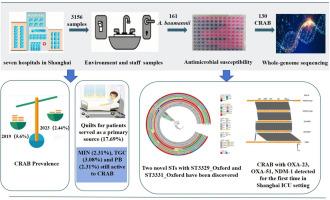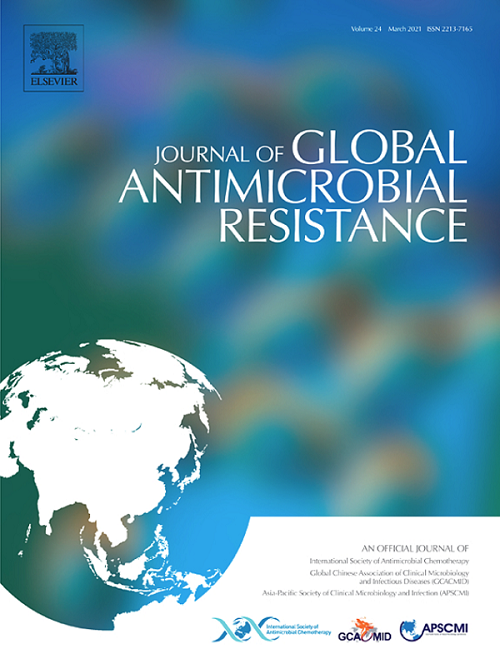上海重症监护病房环境中含有耐碳青霉烯类鲍曼不动杆菌的blaOXA-23、blaOXA-91和blaNDM-1共存的基因组学见解
IF 3.2
3区 医学
Q2 INFECTIOUS DISEASES
引用次数: 0
摘要
目的:研究2019年(covid大流行前)和2023年(covid大流行后)上海7家医院物体表面和医护人员手中分离的耐碳青霉烯类鲍曼不动杆菌(CARB)的传播、流行和基因组特征。方法:采用微量肉汤稀释法和全基因组测序法对分离菌株进行药敏试验。基于VFDB数据库、PubMLST、Kaptive、mobo -suite等工具对耐药基因、多位点序列分型(Multilocus Sequence Typing, MLST)、多糖胶囊和质粒迁移进行评估。结果:在3156份样本中,分离出130株螃蟹。2023年ICU环境中CRAB的患病率(2.44%)明显低于2019年(5.60%)。与患者直接接触的物体是主要传染源(43.85%)。螃蟹对β-内酰胺酶耐药较高,但对米诺环素(2.31%)、替加环素(3.08%)和多粘菌素B(2.31%)耐药较低。鉴定出5株ST_Pasteur和11株ST_Oxford,主要为ST2_Pasteur(93.6%)和ST208_Oxford(40%)。在门把手等物体表面发现了两种名为ST3329和ST3331的新型序列类型(STs)。值得注意的是,两株CARB分离株(编号为2023-AB023和2023-AB033)共携带blaOXA-23、blaOXA-91和blaNDM-1,与此前在中国浙江省报道的一名ICU患者口腔拭子中分离到的具有高环境适应性的DETAB-R21具有高度的基因组相似性。结论:2023年CRAB耐药率较2019年略有下降。然而,泛耐药螃蟹的出现,以及碳青霉烯酶产生菌株(OXA-23、oxa -51样和NDM-1)在2023年的共存,突显了该病原体抗微生物药物耐药性(AMR)的动态进展。这些发现表明,潜在的流行病学转变以克隆多样化和持续的碳青霉烯酶驱动的耐药机制为特征。本文章由计算机程序翻译,如有差异,请以英文原文为准。

Genomic insights of the co-existence of blaOXA-23, blaOXA-91, blaNDM-1 harboring carbapenem-resistant Acinetobacter Baumannii isolates from the intensive care units environment in Shanghai
Objectives
This study assessed the transmission, prevalence and genomic characteristics of carbapenem-resistant Acinetobacter Baumannii (CARB) isolated from object surfaces and healthcare workers' hands in seven hospitals of Shanghai in 2019 (pre-COVID pandemic) and 2023 (post-COVID pandemic).
Methods
CRAB isolates were tested for antimicrobial susceptibility using the broth microdilution method and whole-genome sequencing. Antimicrobial resistance genes, Multilocus Sequence Typing (MLST), polysaccharide capsule and plasmid migration were evaluated based on tools such as VFDB database, PubMLST, Kaptive, MOB-suite, etc.
Results
Of 3,156 samples collected, 130 strains of CRAB were isolated. The prevalence of CRAB in the ICU setting was significantly lower in 2023 (2.44%) than in 2019 (5.60%). Objects that come into direct contact with patients served as a primary source (43.85%). CRAB isolates exhibited higher resistance to β-lactamase antibiotics but lower to minocycline (2.31%), tigecycline (3.08%) and polymyxin B (2.31%). Five ST_Pasteur and eleven ST_Oxford were identified, predominantly ST2_Pasteur (93.6%) and ST208_Oxford (40%). Two novel sequence types (STs) named ST3329 and ST3331 were found in the surface of objects such as door handles. Notably, two CARB isolates (designated 2023-AB023 and 2023-AB033) co-harboring the blaOXA-23, blaOXA-91, blaNDM-1 were found to be high genomic similarity to DETAB-R21 previously isolated from an ICU patient's oral swab with high environmental adaptability, reported in August 2022 in Zhejiang Province of China.
Conclusions
The resistance rate of CRAB was slightly lower in 2023 compared to 2019. However, the emergence of pan-drug-resistant CRAB, along with the coexistence of carbapenemase-producing strains (OXA-23, OXA-51-like, and NDM-1) in 2023, underscore the dynamic progression of antimicrobial resistance (AMR) in this pathogen. These findings suggest a potential epidemiological shift characterized by clonal diversification alongside persistent carbapenemase-driven resistance mechanisms.
求助全文
通过发布文献求助,成功后即可免费获取论文全文。
去求助
来源期刊

Journal of global antimicrobial resistance
INFECTIOUS DISEASES-PHARMACOLOGY & PHARMACY
CiteScore
8.70
自引率
2.20%
发文量
285
审稿时长
34 weeks
期刊介绍:
The Journal of Global Antimicrobial Resistance (JGAR) is a quarterly online journal run by an international Editorial Board that focuses on the global spread of antibiotic-resistant microbes.
JGAR is a dedicated journal for all professionals working in research, health care, the environment and animal infection control, aiming to track the resistance threat worldwide and provides a single voice devoted to antimicrobial resistance (AMR).
Featuring peer-reviewed and up to date research articles, reviews, short notes and hot topics JGAR covers the key topics related to antibacterial, antiviral, antifungal and antiparasitic resistance.
 求助内容:
求助内容: 应助结果提醒方式:
应助结果提醒方式:


